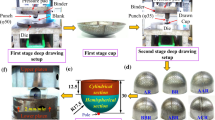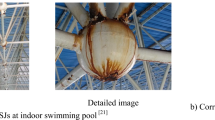Abstract
In this research work, two-stage drawing was employed to fabricate combined geometry shells with hemispherical and cylindrical segments using two types of laser welded blanks, namely similar thickness (LWBs) and dissimilar thickness (LWTBs) of extra deep drawing steels. Four diametrically opposing circular holes of 4 mm and 8 mm were drilled in the cylindrical portion. These shells were quasi-statically crushed between two flat platens to investigate the effect of the presence of hole on crush characteristics such as collapse modes and load–displacement response. The collapse of LWTB shells started with an inward dimple in the hemispherical section and followed by uneven and partial folding of the cylindrical section due to the non-uniform thickness variation across the weld zone. However, it was identified that the presence of 8 mm holes promoted progressive folding with a uniform load–displacement response, while uneven and partial folding was observed in shells with 4 mm holes. The use of Stoughton non-associated flow rule (S-NAFR) in finite element modeling predicted the non-uniform thickness variation and earring profile of the LWTB shells better than Hill48 model. Also, the load–displacement response and modes of collapse during the crushing of all the shells were predicted well using the S-NAFR model. Based on the above findings, it was perceived that the circular holes could be inserted as discontinuities in LWTB shells to suppress the effect of non-uniform thickness distribution on the crushing characteristics.












Similar content being viewed by others
References
X. Song, G. Sun, and Q. Li, Sensitivity Analysis and Reliability Based Design Optimization for High-Strength Steel Tailor Welded Thin-Walled Structures under Crashworthiness, Thin-Walled Struct., 2016, 109, p 132–142. https://doi.org/10.1016/j.tws.2016.09.003
M. Merklein, M. Johannes, M. Lechner, and A. Kuppert, A Review on Tailored Blanks—Production, Applications and Evaluation, J. Mater. Process. Technol., 2014, 214(2), p 151–164. https://doi.org/10.1016/j.jmatprotec.2013.08.015
P. Kaczyński, Z. Gronostajski, and S. Polak, Progressive Crushing as a New Mechanism of Energy Absorption. The Crushing Study of Magnesium Alloy Crash-Boxes, Int. J. Impact Eng., 2019, 124(February 2018), p 1–8.
K. Bandyopadhyay, S.K. Panda, and P. Saha, Investigations into the Influence of Weld Zone on Formability of Fiber Laser-Welded Advanced High Strength Steel, J. Mater. Eng. Perform., 2014, 23(4), p 1465–1479.
B.S. Katiyar, S.K. Panda, and P. Saha, Quasi-Static Crushing Behavior of Stretch Formed Domes of Laser Welded Tailored Blanks, Thin-Walled Struct., 2021, 159(November 2020), p 107288.
M.A. Ahmetoglu, D. Brouwers, L. Shulkin, L. Taupin, G.L. Kinzel, and T. Altan, Deep Drawing of Round Cups from Tailor-Welded Blanks, J. Mater. Process. Tech., 1995, 53(3–4), p 684–694.
S. Chatterjee, R. Saha, M. Shome, and R.K. Ray, Evaluation of Formability and Mechanical Behavior of Laser-Welded Tailored Blanks Made of Interstitial-Free and Dual-Phase Steels, Metall. Mater. Trans. A Phys. Metall. Mater. Sci., 2009, 40(5), p 1142–1152.
U. Reisgen, M. Schleser, O. Mokrov, and E. Ahmed, Optimization of Laser Welding of DP/TRIP Steel Sheets Using Statistical Approach, Opt. Laser Technol., 2012, 44(1), p 255–262. https://doi.org/10.1016/j.optlastec.2011.06.028
A.A. Zadpoor, J. Sinke, and R. Benedictus, Mechanics of Tailor Welded Blanks: An Overview, Key Eng. Mater., 2007, 344, p 373–382. https://doi.org/10.4028/www.scientific.net/KEM.344.373
M. Abbasi, S.R. Hamzeloo, M. Ketabchi, M.A. Shafaat, and B. Bagheri, Analytical Method for Prediction of Weld Line Movement During Stretch Forming of Tailor-Welded Blanks, Int. J. Adv. Manuf. Technol., 2014, 73(5–8), p 999–1009.
Y.M. Heo, S.H. Wang, H.Y. Kim, and D.G. Seo, The Effect of the Drawbead Dimensions on the Weld-Line Movements in the Deep Drawing of Tailor-Welded Blanks, J. Mater. Process. Technol., 2001, 113(1–3), p 686–691.
C.H. Cheng, L.C. Chan, and C.L. Chow, Weldment Properties Evaluation and Formability Study of Tailor-Welded Blanks of Different Thickness Combinations and Welding Orientations, J. Mater. Sci., 2007, 42(15), p 5982–5990.
H. Moayedi, R. Darabi, A. Ghabussi, M. Habibi, and L.K. Foong, Weld Orientation Effects on the Formability of Tailor Welded Thin Steel Sheets, Thin-Walled Struct., 2020, 149(January), p 106. https://doi.org/10.1016/j.tws.2020.106669
K. Bandyopadhyay, S.K. Panda, P. Saha, and G. Padmanabham, Limiting Drawing Ratio and Deep Drawing Behavior of Dual Phase Steel Tailor Welded Blanks: FE Simulation and Experimental Validation, J. Mater. Process. Technol., 2015, 217, p 48–64. https://doi.org/10.1016/j.jmatprotec.2014.10.022
F. Xu, G. Sun, G. Li, and Q. Li, Experimental Study on Crashworthiness of Tailor-Welded Blank (TWB) Thin-Walled High-Strength Steel (HSS) Tubular Structures, Thin-Walled Struct., 2014, 74, p 12–27.
A.G. Mamalis, D.E. Manolakos, K.N. Spentzas, M.B. Ioannidis, S. Koutroubakis, and P.K. Kostazos, The Effect of the Implementation of Circular Holes as Crush Initiators to the Crushing Characteristics of Mild Steel Square Tubes: Experimental and Numerical Simulation, Int. J. Crashworthiness, 2009, 14(5), p 489–501.
B. Arnold and W. Altenhof, Experimental Observations on the Crush Characteristics of AA6061 T4 and T6 Structural Square Tubes with and without Circular Discontinuities, Int. J. Crashworthiness, 2004, 9(1), p 73–87.
H. Taghipoor, A. Ghiaskar, and A. Shavalipour, Crashworthiness Performance of Thin-Walled, Square Tubes with Circular Hole Discontinuities under High-Speed Impact Loading, Int. J. Crashworthiness, 2021 https://doi.org/10.1080/13588265.2021.1981125
H. Nikkhah, A. Baroutaji, and A.G. Olabi, Crashworthiness Design and Optimisation of Windowed Tubes under Axial Impact Loading, Thin-Walled Struct., 2019, 142(April), p 132–148. https://doi.org/10.1016/j.tws.2019.04.052
A.A. Zadpoor, J. Sinke, and R. Benedictus, Finite Element Modeling and Failure Prediction of Friction Stir Welded Blanks, Mater. Des., 2009, 30(5), p 1423–1434. https://doi.org/10.1016/j.matdes.2008.08.018
F. Barlat, J.C. Brem, J.W. Yoon, K. Chung, R.E. Dick, D.J. Lege, F. Pourboghrat, S.H. Choi, and E. Chu, Plane Stress Yield Function for Aluminum Alloy Sheets—Part 1: Theory, Int. J. Plast., 2003, 19(9), p 1297–1319.
F. Barlat, H. Aretz, J.W. Yoon, M.E. Karabin, J.C. Brem, and R.E. Dick, Linear Transfomation-Based Anisotropic Yield Functions, Int. J. Plast., 2005, 21(5), p 1009–1039.
K. Hariharan, N.T. Nguyen, N. Chakraborti, M.G. Lee, and F. Barlat, Multi-Objective Genetic Algorithm to Optimize Variable Drawbead Geometry for Tailor Welded Blanks Made of Dissimilar Steels, Steel Res. Int., 2014, 85(12), p 1597–1607.
D. Kim, W. Lee, J. Kim, C. Kim, and K. Chung, Formability Evaluation of Friction Stir Welded 6111–T4 Sheet with Respect to Joining Material Direction, Int. J. Mech. Sci., 2010, 52(4), p 612–625. https://doi.org/10.1016/j.ijmecsci.2010.01.001
W.A. Spitzig, Effect of Hydrostatic Pressure on Plastic-Flow Properties of Iron Single Crystals, Acta Metall., 1979, 27(4), p 523–534.
W.A. Spitzig, R.J. Sober, and O. Richmond, The Effect of Hydrostatic Pressure on the Deformation Behavior of Maraging and HY-80 Steels and Its Implications for Plasticity Theory, Metall. Trans. A, 1976, 7(10), p 1703–1710.
W.A. Spitzig and O. Richmond, The Effect of Pressure on the Flow Stress of Metals, Acta Metall., 1984, 32(3), p 457–463.
T.B. Stoughton and J.W. Yoon, A Pressure-Sensitive Yield Criterion under a Non-Associated Flow Rule for Sheet Metal Forming, Int. J. Plast., 2004, 20(4–5), p 705–731.
J. Min, J.E. Carsley, J. Lin, Y. Wen, and B. Kuhlenkötter, A Non-Quadratic Constitutive Model under Non-Associated Flow Rule of Sheet Metals with Anisotropic Hardening: Modeling and Experimental Validation, Int. J. Mech. Sci., 2016, 119, p 343–359.
M. Safaei, J.W. Yoon, and W. De Waele, Study on the Definition of Equivalent Plastic Strain under Non-Associated Flow Rule for Finite Element Formulation, Int. J. Plast., 2014, 58, p 219–238. https://doi.org/10.1016/j.ijplas.2013.09.010
A. Bouhamed, H. Jrad, L. Ben Said, M. Wali, and F. Dammak, A Non-Associated Anisotropic Plasticity Model with Mixed Isotropic-Kinematic Hardening for Finite Element Simulation of Incremental Sheet Metal Forming Process, Int. J. Adv. Manuf. Technol., 2019, 100(1–4), p 929–940.
T.B. Stoughton, A Non-Associated Flow Rule for Sheet Metal Forming, Int. J. Plast., 2002, 18(5–6), p 687–714.
K. Hariharan, N.T. Nguyen, N. Chakraborti, F. Barlat, and M.G. Lee, Determination of Anisotropic Yield Coefficients by a Data-Driven Multiobjective Evolutionary and Genetic Algorithm, Mater. Manuf. Process., 2015, 30(4), p 403–413.
D. Anand, D.L. Chen, S.D. Bhole, P. Andreychuk, and G. Boudreau, Fatigue Behavior of Tailor (Laser)-Welded Blanks for Automotive Applications, Mater. Sci. Eng. A, 2006, 420(1–2), p 199–207.
J. Rojek, M. Hyrcza-Michalska, A. Bokota, and W. Piekarska, Determination of Mechanical Properties of the Weld Zone in Tailor-Welded Blanks, Arch. Civ. Mech. Eng., 2012, 12(2), p 156–162. https://doi.org/10.1016/j.acme.2012.04.004
L.C. Chan, S.M. Chan, C.H. Cheng, and T.C. Lee, Formability and Weld Zone Analysis of Tailor-Welded Blanks for Various Thickness Ratios, J. Eng. Mater. Technol., 2005, 127(2), p 179. https://doi.org/10.1115/1.1857936
S. Basak and S.K. Panda, Implementation of Yld96 Anisotropy Plasticity Theory for Estimation of Polar Effective Plastic Strain Based Failure Limit of Pre-Strained Thin Steels, Thin-Walled Struct., 2018, 126(April 2017), p 26–37.
ASTM E-517, Standard Test Method for Plastic Strain Ratio r for Sheet Metal, ASTM international, 2010, p 1–8.
J. Kim, Q.T. Pham, J. Ha, and Y.S. Kim, Constitutive Modeling of Commercial Pure Titanium Sheet Based on Non-Associated Flow Rule and Differential Hardening, Int. J. Mech. Sci., 2022, 230(June), p 107549. https://doi.org/10.1016/j.ijmecsci.2022.107549
A. Tasdemirci, S. Sahin, A. Kara, and K. Turan, Crushing and Energy Absorption Characteristics of Combined Geometry Shells at Quasi-Static and Dynamic Strain Rates: Experimental and Numerical Study, Thin-Walled Struct., 2015, 86, p 83–93. https://doi.org/10.1016/j.tws.2014.09.020
D.M. Neto, M.C. Oliveira, J.L. Alves, and L.F. Menezes, Influence of the Plastic Anisotropy Modelling in the Reverse Deep Drawing Process Simulation, Mater. Des., 2014, 60, p 368–379. https://doi.org/10.1016/j.matdes.2014.04.008
J. Zhu, Y. Xia, H. Luo, G. Gu, and Q. Zhou, Influence of Flow Rule and Calibration Approach on Plasticity Characterization of DP780 Steel Sheets Using Hill48 Model, Int. J. Mech. Sci., 2014, 89, p 148–157.
Acknowledgments
The authors are grateful for the support provided by Prof. Shamik Basak of Department of Mechanical and Industrial Engineering, Indian Institute of Technology Roorkee, India, during the FE simulations of this study.
Author information
Authors and Affiliations
Corresponding author
Additional information
Publisher's Note
Springer Nature remains neutral with regard to jurisdictional claims in published maps and institutional affiliations.
Rights and permissions
Springer Nature or its licensor (e.g. a society or other partner) holds exclusive rights to this article under a publishing agreement with the author(s) or other rightsholder(s); author self-archiving of the accepted manuscript version of this article is solely governed by the terms of such publishing agreement and applicable law.
About this article
Cite this article
Katiyar, B.S., Panda, S.K. & Saha, P. Effect of Circular Hole Discontinuities on Crushing Characteristics of Combined Geometry Shells of Tailor Welded Blanks. J. of Materi Eng and Perform 33, 3034–3049 (2024). https://doi.org/10.1007/s11665-023-08157-0
Received:
Revised:
Accepted:
Published:
Issue Date:
DOI: https://doi.org/10.1007/s11665-023-08157-0




